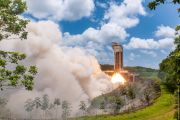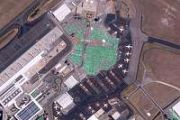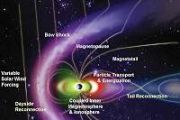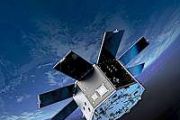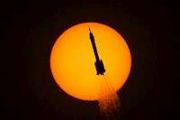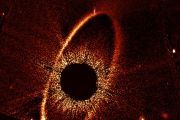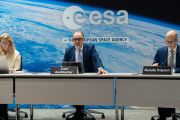
Copernical Team
Unlocking the secrets of supercritical fluids
 A study now published in Nature Communications provides new insights into the behavior of supercritical fluids, a state of matter between liquids and gases, with applications ranging from the pharmaceutical industry to planetary science. The findings, achieved at the Institut Laue Langevin (ILL), were at the limits of current experimental possibilities.
A supercritical fluid is a substance
A study now published in Nature Communications provides new insights into the behavior of supercritical fluids, a state of matter between liquids and gases, with applications ranging from the pharmaceutical industry to planetary science. The findings, achieved at the Institut Laue Langevin (ILL), were at the limits of current experimental possibilities.
A supercritical fluid is a substance Earth Observation advances with Marble Imaging and Reflex Aerospace partnership
 Marble Imaging, supported by Reflex Aerospace, aims to transform the Earth Observation (EO) industry with a constellation of up to 200 small satellites. This initiative seeks to position Marble Imaging as Europe's leading EO company, offering very-high resolution (VHR) images of the entire planet daily. Reflex Aerospace, a German satellite manufacturer, provides satellite platforms known for the
Marble Imaging, supported by Reflex Aerospace, aims to transform the Earth Observation (EO) industry with a constellation of up to 200 small satellites. This initiative seeks to position Marble Imaging as Europe's leading EO company, offering very-high resolution (VHR) images of the entire planet daily. Reflex Aerospace, a German satellite manufacturer, provides satellite platforms known for the Space Force plans to fill Satellite Procurement Gap with Space Test Experiments Platform
 The Space Test Program (STP) office has released the Request for Proposal (RFP) for the Space Test Experiments Platform (STEP) 2.0 contract. This move enables STP to secure complete solutions for the U.S. Space Force's Science and Technology (S and T) experiments.
"The DoD Space Test Program is looking to leverage all the successes from industry to provide proven spacecraft to host the DoD
The Space Test Program (STP) office has released the Request for Proposal (RFP) for the Space Test Experiments Platform (STEP) 2.0 contract. This move enables STP to secure complete solutions for the U.S. Space Force's Science and Technology (S and T) experiments.
"The DoD Space Test Program is looking to leverage all the successes from industry to provide proven spacecraft to host the DoD Meteor captured by weather satellite
 A meteor recently lit up the skies over Spain and Portugal, and was also captured by the Meteosat Third Generation Imager weather satellite hovering 36,000 km away in geostationary orbit.
"While a meteor lit up the skies over Spain and Portugal recently, it was also captured by the Meteosat Third Generation Imager weather satellite hovering 36,000 km away in geostationary orbit."
On
A meteor recently lit up the skies over Spain and Portugal, and was also captured by the Meteosat Third Generation Imager weather satellite hovering 36,000 km away in geostationary orbit.
"While a meteor lit up the skies over Spain and Portugal recently, it was also captured by the Meteosat Third Generation Imager weather satellite hovering 36,000 km away in geostationary orbit."
On NASA launches ground-breaking climate change satellite
 A tiny NASA satellite was launched Saturday from New Zealand with the mission of improving climate change prediction by measuring heat escaping from Earth's poles for the first time.
"This new information - and we've never had it before - will improve our ability to model what's happening in the poles, what's happening in climate," NASA's earth sciences research director Karen St. Germain
A tiny NASA satellite was launched Saturday from New Zealand with the mission of improving climate change prediction by measuring heat escaping from Earth's poles for the first time.
"This new information - and we've never had it before - will improve our ability to model what's happening in the poles, what's happening in climate," NASA's earth sciences research director Karen St. Germain Intelsat enhances satellite lifespan with mission extension vehicles
 Intelsat, operator of a large integrated satellite and terrestrial network and provider of inflight connectivity, will extend broadband, video distribution, and mobile satellite service to customers across three continents using Northrop Grumman's Mission Extension Vehicle (MEV). This technology will add nine years to the Intelsat 10-02 (IS-10-02) satellite.
Geosynchronous Earth orbit (GEO
Intelsat, operator of a large integrated satellite and terrestrial network and provider of inflight connectivity, will extend broadband, video distribution, and mobile satellite service to customers across three continents using Northrop Grumman's Mission Extension Vehicle (MEV). This technology will add nine years to the Intelsat 10-02 (IS-10-02) satellite.
Geosynchronous Earth orbit (GEO Geespace advances LEO satellite constellation for global coverage
 SpaceX's Starlink recently announced that their high-speed internet constellation now connects over 3 million people across nearly 100 countries and territories.
Low Earth orbit (LEO) satellite constellations provide real-time network services to people in remote and underdeveloped areas. As LEO satellite deployments increase globally, commercial aerospace companies are becoming significan
SpaceX's Starlink recently announced that their high-speed internet constellation now connects over 3 million people across nearly 100 countries and territories.
Low Earth orbit (LEO) satellite constellations provide real-time network services to people in remote and underdeveloped areas. As LEO satellite deployments increase globally, commercial aerospace companies are becoming significan Stargazing in broad daylight: How a multi-lens telescope is changing astronomy
 Macquarie University's Huntsman Telescope has successfully demonstrated daytime astronomy using an array of Canon camera lenses and offering the potential to continuously monitor celestial objects and satellites.
Astronomers at Macquarie University have pioneered a new technique for observing celestial objects during the day, potentially allowing around-the-clock visual monitoring of satellites
Macquarie University's Huntsman Telescope has successfully demonstrated daytime astronomy using an array of Canon camera lenses and offering the potential to continuously monitor celestial objects and satellites.
Astronomers at Macquarie University have pioneered a new technique for observing celestial objects during the day, potentially allowing around-the-clock visual monitoring of satellites Scientists observe CO2 and CO ices in the outer solar system
 For the first time, carbon dioxide and carbon monoxide ices have been observed in the far reaches of our solar system on trans-Neptunian objects (TNOs).
A research team, led by planetary scientists Mario Nascimento De Pra and Noemi Pinilla-Alonso from the University of Central Florida's Florida Space Institute (FSI), made the findings by using the infrared spectral capabilities of the Jame
For the first time, carbon dioxide and carbon monoxide ices have been observed in the far reaches of our solar system on trans-Neptunian objects (TNOs).
A research team, led by planetary scientists Mario Nascimento De Pra and Noemi Pinilla-Alonso from the University of Central Florida's Florida Space Institute (FSI), made the findings by using the infrared spectral capabilities of the Jame Astronomers Discover 15 New Exoplanets and Measure Mass of 126 Others
 Using data from the Transiting Exoplanet Survey Satellite (TESS) and W.M. Keck Observatory on Mauna Kea in Hawaii, an astronomer at the University of Kansas has led a study revealing 15 new exoplanets and determining the mass of 126 others. The findings provide new insights into the composition of exoplanets and their star systems.
The study, part of the TESS-Keck Survey, is published in T
Using data from the Transiting Exoplanet Survey Satellite (TESS) and W.M. Keck Observatory on Mauna Kea in Hawaii, an astronomer at the University of Kansas has led a study revealing 15 new exoplanets and determining the mass of 126 others. The findings provide new insights into the composition of exoplanets and their star systems.
The study, part of the TESS-Keck Survey, is published in T 










